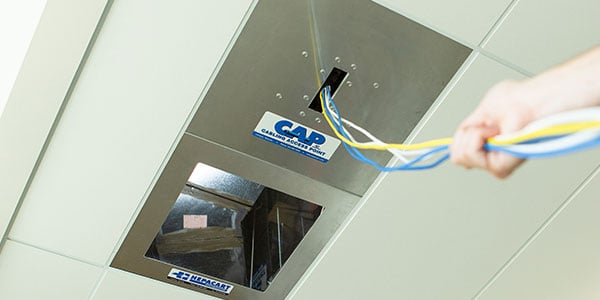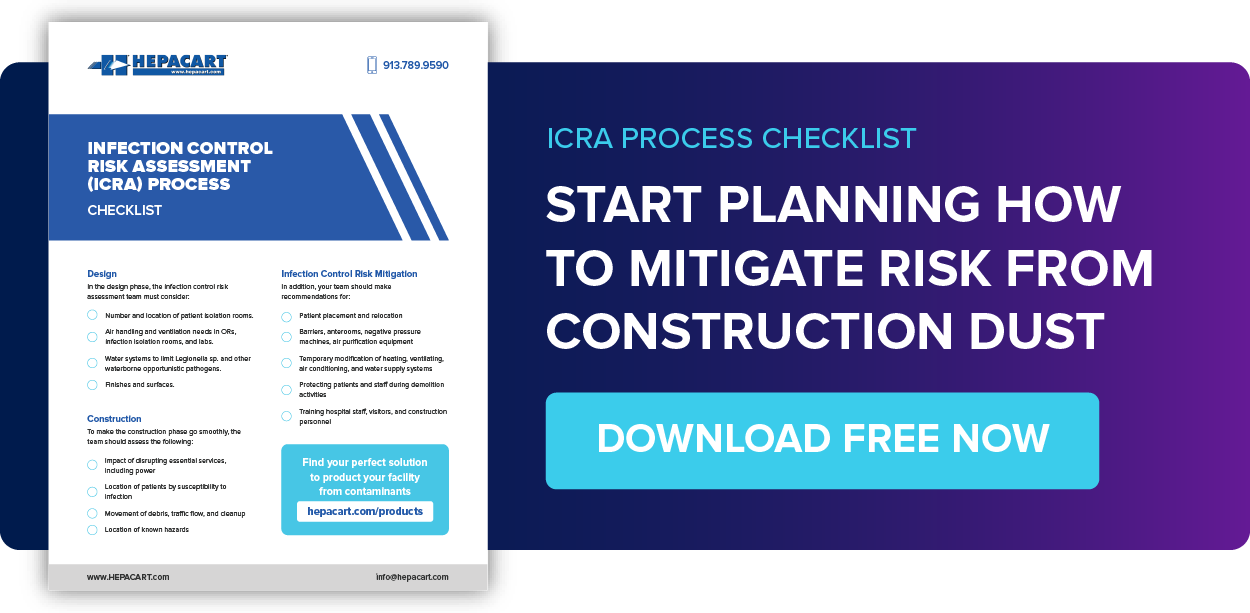Share this
4 Dust Containment Tools that Every Healthcare Facility Manager Needs
by HEPACART on Jul 20, 2021
Do you have the right tools to contain construction dust and prevent patients and staff from getting sick?
As a facility manager, have you gotten a call whereupon you learn that your already large workload is about to get even bigger? Perhaps it’s from the entities above and beyond your station calling to inform you that an extensive renovation is being planned and started within the next year — one large enough to complicate your job for a while. Sure, their excitement is palpable, but your left eye starts to twitch uncontrollably.
So, what does this have to do with dust containment tools? Well, everyone knows that selecting the right tools makes a job easier, and you are about to have LOTS of dust in the air. Ergo, this helpful article will give you insight into the tools that will help you keep airborne dust at bay, eliminating contaminated air that could wreak havoc on patients who are already compromised.
1. HEPACART Dust Containment Cart
In 2006, a company called TED Systems was called upon to test 350 fire alarm devices located above the ceiling in a children's hospital. Before removing a single ceiling tile, of course, they had to rig a makeshift tent around it with zip poles and plastic, bring in a ceiling access ladder, and set up a blower to create negative pressure to contain any dust that might escape. The problem was, the whole rig took half an hour to set up or take down. Further, they did not know the exact location of each alarm. This meant they might lift a tile, only to see they were nowhere near an alarm. As HEPACART lead engineer Jeff Pirner tells the story, "we were going to be there the rest of our lives."
Out of sheer necessity, then, the first HEPACART dust containment carts were born. Early steel-and-wood prototypes quickly gave way to welded aluminum versions. Our dust containment solution was so obviously superior that once other contractors in the hospital saw them, they wanted to buy them. In 2007 the newly created HEPACART company began selling sleek aluminum units looking very much like the HEPACART dust containment unit you can buy today.
As early users quickly discovered, efficiency goes up dramatically with a mobile dust containment unit. Roll it beneath a tile, put on the parking brake, plug in the power cord, raise the fire-retardant telescoping enclosure until the foam seal presses against the ceiling. That's it. You're ready to enter the ceiling in a minute or two instead of half an hour or more. Plus, the interior LED lights and HEPA filtration provides a clean and safe working environment.
Once the job is finished, workers can leave the ladder, tools, and supplies inside before closing up the unit just as quickly as they set it up.
2. Cabling Access Point (CAP)
Many jobs involve pulling Ethernet cable, optical fiber, or electrical wiring through the ceiling in a hospital or other high-risk environment. The simplest way to do that would involve two HEPACARTs — the first used to feed cables into an open ceiling tile, and the second providing access to the ceiling at many subsequent points to pull, secure, connect, and test.
However, much as we might get warm and fuzzy feelings inside as we contemplate selling lots of HEPACART units, we must tell you that a more economical approach is available.
 In place of that first dust containment cart, substitute a Cabling Access Point (CAP), fitting it neatly in place of a ceiling tile. The CAP provides a small opening with rollers to guide cables gently through it into the plenum space above. It comes in varied designs to accommodate everything from delicate optical fiber cables to large cable bundles, as well as various tile openings.
In place of that first dust containment cart, substitute a Cabling Access Point (CAP), fitting it neatly in place of a ceiling tile. The CAP provides a small opening with rollers to guide cables gently through it into the plenum space above. It comes in varied designs to accommodate everything from delicate optical fiber cables to large cable bundles, as well as various tile openings.
With a CAP in place, workers can feed cable quickly and cleanly, without exposing anyone to dust from above the ceiling grid. As with everything HEPACART, installing and removing any CAP product is a simple matter, taking only a minute or two.
3. AnteRoom Total Room Isolation
Now we come to the part of this post that directly addresses your need for an antacid: construction. If you thought dust was a big deal in the maintenance scenarios just described, hold on to your Maalox because things are about to get interesting.
Let's start with demolition, construction, and renovation confined to a single room. Instead of entering via a ceiling tile, you need to walk through a door. HEPACART's AnteRoom is designed for safe, dust-free access to any room. Roll the all-aluminum AnteRoom up to the wall in front of the door, install it in less than five minutes, and you have a dust-containing, clothes-changing vestibule. In addition, it comes with external duct adapters for any negative air machine, not just one of ours.
Now you've created an isolated work environment that contains dust and meets ICRA Class IV specifications while providing an entry and exit point via an anteroom.
4. RealWall & LiteBarrier Dust Containment Walls
Finally, we've come full circle to that stomach-clenching phone call about that major renovation project. Since we've described products that provide ways to enter ceilings and rooms safely and efficiently, why not apply the same thinking to walls.
Typically during construction projects, temporary walls can consist of anything from heavy plastic sheeting over a wood framework to reusable fabric to conventional drywall (really not the best temporary solution with the labor costs, demolition, and the waste removal required at the end).
STARC Systems RealWall and LiteBarrier are reusable, portable wall systems that include doors, windows, ports for air management, and a clean look that reflects well on your organization while helping you meet requirements for dust and fire containment.
How fast can two workers put up a wall? Here's a time-lapse video of experienced installers erecting 97 feet of RealWall in one hour.
Conclusion
We know that healthcare facility management is a big job and that safeguarding the health of patients, staff, and visitors during maintenance and construction is an important part of it. The right tools can make a big difference in how efficiently and effectively you accomplish that goal. More reading
More reading

